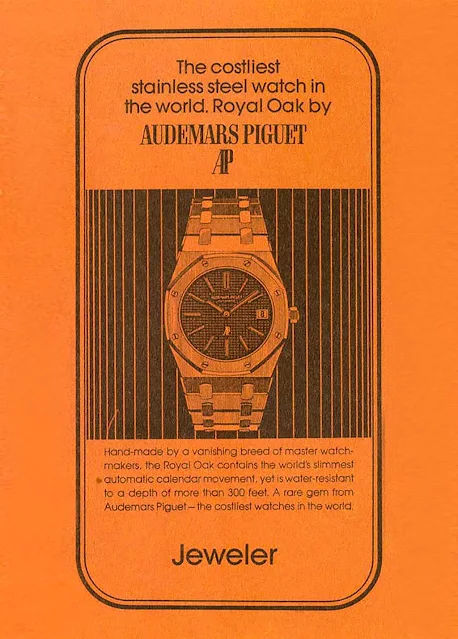Basel, April 1972: at the annual Swiss Watch Show (later renamed BaselWorld), Audemars Piguet introduced a luxury steel watch with integrated bracelet characterized by a daring and revolutionary design. After the initial disconcert of the market, the watch - the Royal Oak - become a huge international success and one of the most iconic watches ever.
Original 1972 Royal Oak ref. 5402
But let's step back in time.
At the very beginning of the seventies, Audemars Piguet, just like many other Swiss watch manufacturers, was facing troubled financial conditions. Quartz watches from Japan caused a serious crisis - the period is often referred to as "the quartz crisis" - to the Swiss watch making industry which had no clear ideas on how to stop the dramatic sales drop.
In 1971 Audemars Piguet realized that, without a disruptive change, a financial collapse was inevitable. Elaborating some feedback that they received from the Italian market about possible interest for a steel luxury watch, the management of the manufacture decided it was time to introduce something totally new, a sporty yet elegant timepiece as never seen before.
The designer of choice for this task was a designer born in Geneva in 1931 from an Italian father and a Swiss mother: Gerald Genta. Not a new designer, rather one of the most famous watch designer at that time, having created successful watches for Universal Genève (Polerouter Microtors, White Shadow, Golden Shadow), Omega (Constellation) and Patek Philippe (Golden Ellipse).
On the eve of the 1971 Basel fair (one year before the launch) Audemars Piguet's managing director at the time, Georges Golay, called Gerald Genta at 4pm explaining that the Italian market was expecting an “unprecedented steel watch" for which he needed a design by the following morning. A sports watch for all occasions with the most beautiful finishes ever seen.
By the morning after Gerald Genta had invented the watch that was to become Royal Oak. He will later state that the Royal Oak was the masterpiece of his career. Genta was also the designer of another iconic timepiece, the Patek Philippe Nautilus launched in 1976 and whose detailed history you can read here.
The original Royal Oak sketch made by Gerald Genta
Inspired by a traditional diver’s helmet, this revolutionary steel watch was characterized by an octagonal shaped bezel secured by eight visible hexagonal gold screws, visible water resistance gasket and a dial adorned with exclusive blue petit tapisserie motif.
Originally, the hexagonal crown was finished with a simple satin-brushed circle. It wasn't until the late 1990s that Audemars Piguet introduced the AP monogram on the crown.
The crown with satin-brushed circle of the Royal Oak 5402ST (1972).
On the right, the crown of reference 15202ST (2002)
On the right, the crown of reference 15202ST (2002)
The watch was slim, just 7 mm, but pretty large (at that time) having a case diameter of 39 mm. To complete the watch, an integrated - and very complex to build - bracelet.
The U.S. Patent 3.756.017 filed by Gerald Genta
Curiously, the first prototypes were fabricated in white gold as machining pieces of high-grade steel to Genta’s specifications was very difficult and expensive at the time and could not be justified for the initial prototypes.
The movement of choice was the beautifully finished self-winding Calibre 2121, which is still used today for the Royal Oak Jumbo ref.15202. The Calibre 2121 was based on the Audemars Piguet Calibre 2120 with the integration of a date complication.
The self-winding Calibre 2120
It is interesting to mention that the Calibre 2120 was introduced in 1967 as the result of a project led by Jaeger-LeCoultre, with the technical contribution of Audemars Piguet and the funding of Audemars Piguet, Patek Philippe and Vacheron Constantin, for the creation of an ultra-thin automatic movement. The joint effort produced the Jaeger-LeCoultre Calibre 920, a highly innovative and reliable movement, that each of the three funding customers renamed and customized (the Patek Philippe 28-255 C was used for the Nautilus while the Vacheron Constantin 1120 powered the 222 model).
The overall height of the Calibre 2121, beating at 19,800 vibrations per hour, was a mere 3.05 mm. Thanks to the anti-shock system, the movement was suitable for being used in a sport watch like the Royal Oak.
Considering that the design theme was inspired by a diver's brass helmet, as Genta confirmed, the name itself had to be nautical-related. Audemars Piguet chose Royal Oak which came from the name of a series of eight vessels (remember that the bezel is octagonal) of Britain's Royal Navy which in turn took their name from the ancient hollowed oak tree within which the King Charles II of England hid to escape the Roundheads - the supporters of the Parliament during the English Civil War - following the Battle of Worcester in 1651.
Introduced at the price of 3300 Swiss Francs, this never-seen-before steel timepiece was more expensive than a gold Patek Philippe dress watch and more than ten times the cost of a Rolex Submariner. The message was certainly bold: haute horlogerie could come up with prestigious timepieces without necessarily relying on precious metals. From this point forward, it was the design, the precision of the execution, and the quality of the movement that counted.
Advertisement insert realised for the United States highlighting the Royal Oak's price -1974
But there was no immediate take-off for this line. The Royal Oak was the target of fierce initial criticism. Disruptive design, visible gasket and screws, integrated bracelet, exorbitant price tag: there was were enough for many detractors to say that Audemars Piguet was going to be bankrupt in few months.
However, the allure and the quality of the Royal Oak could not be negated for long. Collectors and trend setters started adopting the watch which, with its decidedly different design, won over a discerning and informed audience becoming a huge success for Audemars Piguet and the symbol of the manufacturer of Le Brassus.
Advertising campaigns emphasizing the exclusivity of the Royal Oak
Audemars Piguet built a first series of 1000 pieces which is known by collectors as the A-series of reference 5402. It took more than one year for Audemars Piguet to sell all the first 1000 Royal Oaks but then sales finally took off. After the first A-series, Audemars Piguet still used A serial numbers for other 1000 pieces, then passed to B and C serial numbers.
This first Royal Oak A-series is still the most sought after by collectors and it is easy to recognize for the AP initials placed above 6 o'clock rather than at 12 o'clock like successive series.
A Royal Oak 5402ST No. A26 - 1972
Over the following years, Audemars Piguet introduced many variations of the original Royal Oak adopting precious metals, leather and rubber straps as well as new technical solutions and complications.
The first Royal Oak Perpetual Calendar Calibre 2120/2800 was designed in 1981 to be the world’s thinnest model of its kind, endowed with a mechanical memory taking account of all calendar variations including months and leap year and requiring no manual intervention before the year 2100.
Royal Oak Perpetual Calendar - 1981
Featuring a white dial with secondary dials for day and date displays at 9 and 3 o’clock framing a moon-phase display at 6, all powered by an entirely in-housed developed mechanism, the Royal Oak Day Date Moonphase offered an excellent alternative to the perpetual calendar movement.
Royal Oak Day/Date Moonphase - 1984
To mark the 20th anniversary of the Royal Oak, the first Royal Oak Offshore was designed to cater the tastes of sport enthusiasts and young people. In fact, the designer of the Offshore - Emmanuel Gueit - was just 22 year old when he was given the task.
The concept behind this model was the “deconstructed” approach to the timepiece, intended to reveal how it was built and its key elements, like the the massive visible black gasket on the bezel. The case had a size of 42 mm, a normal size today but shock at the time, which brought the watch to be nicknamed "The Beast".
When the Offshore was introduced at Basel 1993, a lot of purists were disappointed, including Gérald Genta which "invaded the booth shouting that his Royal Oak had been completely destroyed”, as Gueit recalls. As for the original Royal Oak, also the Offshore turned out to be a great success.
Royal Oak Offshore Chronograph - 1993
The Royal Oak Concept was the 30th anniversary tribute to the Royal Oak: an authentic “lab watch" embodying absolute performance through a blend of technical sophistication and extreme resistance. The case was the first ever to borrow a superalloy from the aeronautical industry: alacrite 602, the hardest material available at the time.
Royal Oak Concept - 2002
In 2010 Audemars Piguet presented the Royal Oak Equation of Time combining four high complications: a perpetual calendar, a precision display of the lunar cycle, the equation of time (which displays the difference between “true” solar time and conventional time), and civil sunrise and sunset times.
Royal Oak Equation of Time - 2010
To celebrate the 40 years of the Royal Oak, in 2012 Audemars Piguet released an updated 15202 reference which was even closer to the original version bringing back the "Petit Tapisserie2 dial pattern and the AP initials at 6 o'clock.
On the 29th of March 2021, Audemars Piguet's CEO François-Henry Bennahmias revealed that the Royal Oak “Jumbo” Extra-Thin 15202 would be replaced by a new model in 2022.
This happened in January 2022 with the introduction of the Royal Oak “Jumbo” Extra-Thin 39 mm ref. 16202 created to celebrate the 50th anniversary of the most successful watch of the brand.
Royal Oak "Jumbo" Extra-Thin 39 mm ref. 16202 - 2022
Its main new feature is represented by the Manufacture’s self-winding movement Calibre 7121 which replaces the Calibre 2121 introduced on the original Royal Oak.
The result of five years of development, the new Calibre 7121 guarantees more autonomy than its predecessor (55 hours vs 40) thanks to a larger barrel. It is also equipped with a contemporary central oscillating weight mounted on ball bearings that utilises two reversers developed in-house to ensure bidirectional winding. The openworked oscillating weight in 22-carat gold features a “50 years” logo that will be fitted to the Royal Oak anniversary models throughout 2022.
Only subtle changes have been performed on the 39 mm x 8.1 mm case. The bevels adorning the top and the bottom of the case have been enlarged to enhance the play of light between the satin-finished and polished surfaces.
Despite many variations, the "Jumbo" (ref. 15202 until 2021 and now ref. 16202) remains the most appreciated Royal Oak, adopting the same case as the original but with a sapphire exhibition back to let the owner admire the movement.
On the left the original Royal Oak ref. 5402, in the middle the 40th anniversary ref. 15202 and, on the right, the ref. 16202 launched in 2022
After more than 50 years, the appeal of the Royal Oak is stronger than ever.
By Alessandro Mazzardo.
Latest revision June 3, 2024.
© Time and Watches. All Rights Reserved. Copying this material for use on other web sites or other digital and printed support without the written permission of Time and Watches or the copyright holder is illegal.
Latest revision June 3, 2024.
© Time and Watches. All Rights Reserved. Copying this material for use on other web sites or other digital and printed support without the written permission of Time and Watches or the copyright holder is illegal.

































